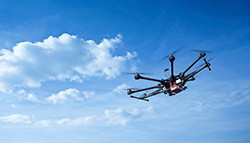 Unmanned aircraft systems (UAS), or drones, can be useful and powerful tools for organizations. But this futuristic technology does come with its risks—crashes, injuries, and potentially liability for invasion of privacy. So before you use a drone, consider the risks involved and how to manage them.
Unmanned aircraft systems (UAS), or drones, can be useful and powerful tools for organizations. But this futuristic technology does come with its risks—crashes, injuries, and potentially liability for invasion of privacy. So before you use a drone, consider the risks involved and how to manage them.
Your risk management strategy should include safe operating procedures and adherence to local, state, and federal regulations. In particular, the Federal Aviation Administration (FAA) released new UAS regulations. So when you’re ready to take flight, make sure you’re following these rules!
What Are The Rules?
Though drones have been used for several years, there was no formal regulation in place until recently. On June 21, 2016 the FAA issued rules regarding the routine commercial use of small unmanned aircraft systems. These rules become effective on August 29, 2016. The FAA shares that the rules “are designed to minimize risks to other aircraft and people and property on the ground.”
Who Is Impacted?
The rules apply to those who want to fly drones for commercial use or non-hobbyist use. This could be mapping, land surveys, photography services, roof inspections, law enforcement surveillance, search & rescue, documenting and investigating accidents or crime scenes, and more.
Know Before You Fly, an education campaign in partnership with the Association for Unmanned Vehicle Systems International, Academy of Model Aeronautics, and the FAA, defines commercial use of UAS as any commercial use in connection with a business including:
- Selling photos or videos taken from a UAS
- Using UAS to provide contract services, such as industrial equipment or factory inspection
- Using UAS to provide professional services, such as security or telecommunications
- Using UAS to monitor the progress of work your company is performing
Government entities must follow the same requirements as business users. Alternatively, they may apply for a blanket public Certificate of Authorization (COA). Learn more about the options for public entities at Know Before You Fly.
What Are The Requirements?
According to the FAA, the requirements for flying a UAS commercially are as follows:
Remote Pilot:
- The person operating of the UAS must be at least 16 years old. They must also have a remote pilot airman certificate with a small UAS rating or be directly supervised by a person who does hold the certificate.
- In order to qualify for a remote pilot certificate, a person must demonstrate aeronautical knowledge by methods specified in the rule, be vetted be the Transportation Security Administration, and be at least 16 years old.
Aircraft:
- UAS must weigh less than 55 lbs.
- The remote pilot, or the person supervising, must conduct a preflight check of the UAS to ensure it is safe for operation.
Operating Rules:
- Must fly no higher than 400 feet in the air.
- At all times, the UAS must remain in the visual line-of-sight of the remote pilot or someone in communication with the operator.
- Can only be operated in daylight hours or civil twilight (30 minutes before official sunrise to 20 minutes after official sunset).
- Maximum groundspeed of 100 mph.
- May not operate over any persons not directly participating in the operations.
- Must yield right of way to other aircraft.
For the complete requirements and rules, see the FAA’s summary of the small unmanned aircraft rule part 107.
What About Privacy Concerns?
The new rule does not directly address the potential privacy issues related to the use of UAS. But the FAA is taking action to address this concern by providing recommended privacy guidelines to all drone users when they register, educating commercial pilots during certification, and issuing guidance to local and state governments. They also encourage all pilots to check their local and state laws before using drones to gather data.
Will Insurance Cover You If Something Goes Wrong?
You need to assure that you have the proper insurance if something goes wrong. Bodily injury or property damage caused by a drone, as well as damage to the drone itself, are likely not covered by your standard insurance policies. But stand-alone policies or endorsements are available. Insurance may also be available to cover possible invasion of privacy claims. Talk to your risk advisor to ensure you’re covered.
Before your organization considers drone use, review the risks involved and the FAA regulations to ensure you are flying safely and consult your risk advisor to make sure you’re covered.



